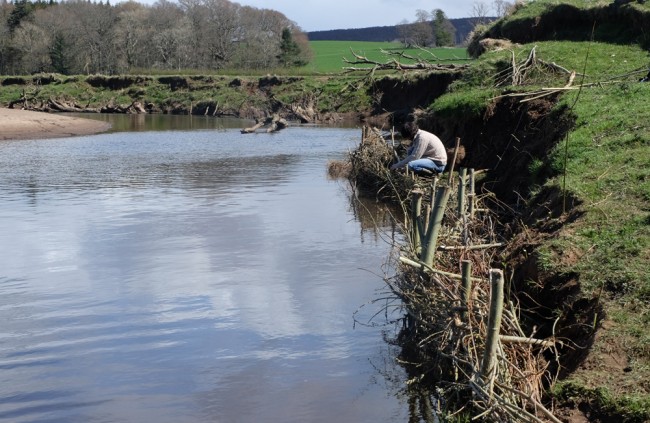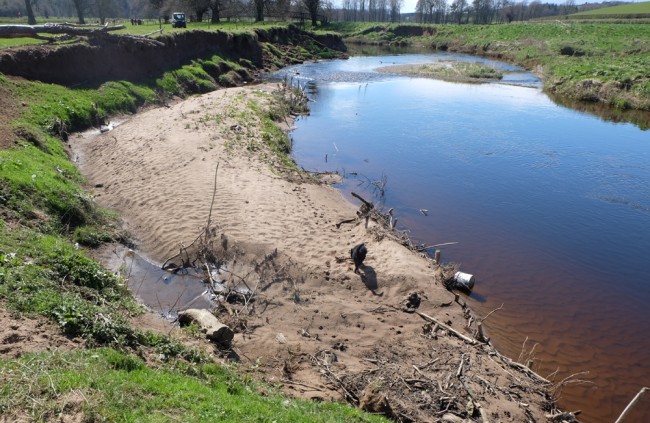What a great day to be out on any river, enjoying the fresh air, the sunshine, the atmosphere, the company of friends and colleagues, and doing something to benefit both river and river users. While we never expected a great rush of willing anglers to come along and learn new skills and get to know the Trust and its staff, I can only say, I had hoped for at least some River Girvan anglers to show willing and take part. Maybe we didn’t publicise this we’ll enough but our face book page and web blogs receive thousands of hits so I would have thought the message was seen by many and more would have turned up.

Not many but some very very welcome volunteers. Thanks to each and every one of them without whom we couldn’t have delivered this day or these improvements.
On a positive note, we had Charlie from Stirling, Simon from Kirchmichael Syndicate upstream, Brian from the Kilkerran syndicate, Gary and Jim from the upper Irvine, Nick from the Ayr and Police constables Murray and Graeme dropped in to see the work and have a chat about another matter. and of course Muir, Struan Gordon and myself from the Trust. Jenny Ferguson from Kilkerran and the DSFB dropped in too.
We had spent the best part of two days harvesting willow for this day and we needed every single bit of it and more. It is incredible how much willow you go through when using these techniques. Gary and Jim brought a couple of bags of cuttings that they had collected and prepared too.
Previously we had blogged about this erosion and our plans to stabilise the banks and that report can be found here https://www.ayrshireriverstrust.org/blog/2015/09/12/8066/

Gathering enough willow is the hardest part of this work.
We started by weaving willow in the downstream area, badly affected by erosion. The water was too deep to do anything on the apex of the bend but near the tail of the pool, the river threatened to remove tomes of soil and bank so we added a short stretch of woven willow there that should root quickly into the bed and bank and trap silt during spates.

The first area where we started off this morning. The near bank was eroding rapidly (due to grazing pressures and previous straightening). Tonnes of nutrient rich soil have already been lost to the river and more was likely. This contributes to diffuse pollution, reducing water quality, invertebrate diversity and fish spawning success and densities.

Making a good start by driving the willow stakes into the river bed

It doesn’t take too long with especially when there’s a few willing bodies to lend a hand. There’s a lesson here for anglers! The benefits of this work will be felt downstream.

It may not be the neatest willow spilling but we care more about function than form. These willows will trap sediments, knit the bankings together as their roots develop mass, offer fish cover, drop leaf litter (food for invertebrates and consequently fish), slow flows, deflect the flow and ultimately reduce erosion thereby improving water quality.
Hopefully this section will prevent further loss at the tail of the pool and hold things together. As the willow grows, trailing branches will grow, reducing pressure on the banking and add fish cover and leaf litter to the river. This is a reasonably well stocked area for trout but I image that it will only improve as a result of this work. If the syndicate can work to extend this section a short distance, we may be able to assist further at a later date with the huge erosion on the apex of the bend but we will wait and see and discuss this further with SEPA as it is a CAR licence/registration activity.
Once the lower section was complete, we headed a couple of hundred metres upstream where Brian had previously installed hazel spilling that had worked well. Unfortunately Hazel doesn’t root and can become dislodged or rot through time.

Previous efforts to stabilise this massive area of erosion have worked but being made of Hazel rather than willow, they won’t last so we added to this day. By adding willow, we aim to encourage a living reinforced bank that will cut erosion and off the other benefit mentioned above. We also planted lots of willow cuttings across the deposited said bank to encourage cover and increase stability.
We intended weaving willow into his spilling to ensure it would hold together and add cover and root mass through time. Instead we decided to use willow faggots staked into place on top of the existing spilling. This is a quicker technique but uses far more willow in the process. It will be interesting to compare the two areas as they establish themselves and to see if there’s any benefit to one over the other. While the willow was being installed, Gary and several other volunteers pushed willow cuttings into the eroding banks and areas of deposition. These should root very quickly, gain adding root mass to help hold the banks together.

This time we used willow faggots (bundles) staked into the tope of the previously installed Hazel spilling. Hopefully, this will allow deposition to continue rebuilding the eroded bank. Willow cuttings were planted across the area.

Progress using faggots was quicker but used far more material. We will compare results to see if there any greater benefit to either technique. Charlie was planting cuttings into the face of the bank to help hold it together.

The upper end of the existing Hazel spilling has had willow faggots added to the top of it. This should allow the deposition to continue and willow roots should hold the bank together better.
To complete this work, the DSFB has agreed to fence part of the area to exclude livestock which are in fact driving this erosion. Sheep and cattle destabilise bankings through, poaching, grazing, and physical damage. Sheep lie in the shelter of the weather and rub against bare soils, creating and leaving scars that through time increase and collapse. They will also graze the willow as it starts to grow so even getting a temporary scare fence (electric) in place should make a huge difference.
We will report how things develop later this year and in years to come through these pages so keep an eye out for updates.

